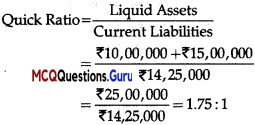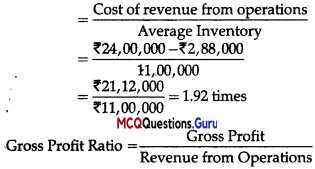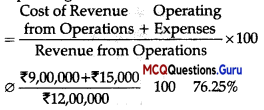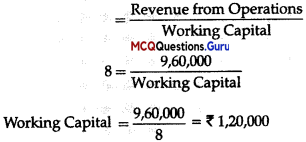Accounting Ratios Class 12 MCQs Questions with Answers
Accounting Ratios Class 12 MCQ Chapter 10 Question 1.
The ……………… may indicate that the firm is experiencing stock outs and lost sales.
(A) Average payment period
(B) Inventory turnover ratio
(C) Average collection period
(D) Quick ratio
Answer:
(B) Inventory turnover ratio
Explanation:
The inventory turnover ratio may indicate that the firm is experiencing stock outs and lost sales. Average Payment Period is the average number of days a business takes to pay its creditors Average Collection Period is the average number of days a firm takes to get its payment from the debtors. Quick Ratio is the ratio between the liquid assets and current liabilities.
![]()
Accounting Ratios MCQ Chapter 10 Class 12 Question 2.
The current ratio of Vidur Pvt. Ltd. is 3 : 2. The accountant wants to maintain it at 2 : 1. Following options are available :
(i) He can repay bills payable
(ii) He can purchase goods on credit
(iii) He can take a short-term loan
Choose the correct option :
(A) Only (i) is correct.
(B) Only (ii) is correct.
(C) Only (i) and (iii) are correct.
(D) Only (ii) and (iii) are correct.
Answer:
(A) Only (i) is correct.
Explanation:
In order to increase the Current ratio, the current liabilities need to be decreased, thus, he can only replay Bills Payable. If he purchases goods on credit or takes short-term loans it will increase the current liabilities.
MCQ Of Accounting Ratios Class 12 Chapter 10 Question 3.
Which of the following is not an activity ratio ?
(A) Inventory turnover ratio
(B) Interest coverage ratio
(C) Working capital turnover ratio
(D) Trade receivables turnover ratio
Answer:
(B) Interest coverage ratio
Explanation:
Interest coverage ratio is a solvency ratio.
![]()
Accounting Ratios MCQs Class 12 Chapter 10 Question 4.
The …………… measures the activity of a firm’s inventory.
(A) average collection period
(B) inventory turnover
(C) liquid ratio
(D) current ratio
Answer:
(B) inventory turnover
Explanation:
The inventory turnover ratio measures the activity of a firm’s inventory. Average collection period measures the time taken by the debtors to pay back. Liquid Ratio measures the amount of liquid assets the firm has for every current liability. Current Ratio is the ratio between current assets and liabilities.
Accounting Ratio MCQ Chapter 10 Class 12 Question 5.
…………… are especially interested in the average payment period, since it provides them with a sense of the bill-paying patterns of the firm.
(A) Customers
(B) Stockholders
(C) Lenders and suppliers
(D) Borrowers and buyers
Answer:
(C) Lenders and suppliers
Accounting Ratios MCQs Class 12 Chapter 10 Question 6.
The …………… ratios provide the information critical to the long run operation to the firm.
(A) liquidity
(B) activity
(C) solvency
(D) profitability
Answer:
(C) solvency
Explanation:
Solvency Ratio is one of the various ratios used to measure the ability of a company to meet its long-term debts.
![]()
MCQ On Accounting Ratios Chapter 10 Question 7.
X Ltd. has a Debt-Equity Ratio of 3 :1. According to the management, it should be maintained at 1:1. What are the choices in front of management to do so.
(A) Increase equity
(B) Reduce debt
(C) Both, i.e, increase equity and reduce debt
(D) All of the above
Answer:
(D) All of the above
Explanation:
In order to equalize Debt-equity ratio, the company needs to either increase equity or reduce debt or do both.
![]()
Accounting Ratios MCQ Class 12 Chapter 10 Question 8.
Pick the odd one out :
(A) Debt to Equity Ratio
(B) Proprietary Ratio
(C) Interest Coverage Ratio
(D) Inventory Turnover ratio
Answer:
(D) Inventory Turnover ratio
Explanation:
Only inventory turnover ratio is a turnover ratio rest all are solvency ratios.
Question 9.
Pick the odd one out:
(A) Gross Profit Ratio
(B) Return on Investment
(C) Net Profit Ratio
(D) Acid Test Ratio
Answer:
(D) Acid Test Ratio
Explanation:
Only Acid Test Ratio is the liquidity ratio, rest all are profitability ratios.
![]()
Assertion And Reason Based MCQs
Directions: In the following questions, a statement of Assertion (A) is followed by a statement of Reason (R). Mark the correct choice as:
(A) Both Assertion (A) and Reason (R) are true, and Reason (R) is the correct explanation of Assertion (A).
(B) Both Assertion (A) and Reason (R) are true, but Reason (R) is not the correct explanation of Assertion (A).
(C) Assertion (A) is true, but Reason (R) is false.
(D) Assertion (A) is false, but Reason (R) is true.
Question 1.
Assertion (A): The standard ratio of current ratio is 2 : 1.
Reason (R): A high operating ratio leaves a high margin to meet non-operating expenses.
Answer:
(A) Both Assertion (A) and Reason (R) are true, and Reason (R) is the correct explanation of Assertion (A).
Question 2.
Assertion (A): Debt to Equity Ratio of 2 : 1 is considered satisfactory. Generally a Low Ratio is considered favourable.
Reason (R): This ratio indicates the proportionate claims of owners and outsiders on firm’s assets. High Ratio shows claims of outsiders are greater but Low Ratio shows outsiders claims are less,
Answer:
(A) Both Assertion (A) and Reason (R) are true, and Reason (R) is the correct explanation of Assertion (A).ct.
Question 3.
Assertion (A): Liquid ratio reveals strength of liquidity of a business unit.
Reason (R): Liquid ratio is the one of the various ratios used to measure the ability of a company to meet its long-term debts.
Answer:
(C) Assertion (A) is true, but Reason (R) is false.
Explanation:
Liquid ratio analyses liquid assets and liquid liabilities of a business unit in order to assess the extent of liquidity.
![]()
Question 4.
Assertion (A): Higher the Gross Profit ratio, good for the business, lower ratio not good for the business.
Reason (R): It reflects the efficiency with which a firm produces its products. A high gross profit ratio indicates that the organization is able to produce at a relatively lower cost.
Answer:
(A) Both Assertion (A) and Reason (R) are true, and Reason (R) is the correct explanation of Assertion (A).
Explanation:
The gross profit should be sufficient to cover all operating expenses and to build up reserves after paying all fixed interest charges and dividends.
Case-Based MCQs
I. Read the following information and answer the given questions:
| Year | 2020 | 2019 | 2018 |
| Amount | (In ₹) | (In ₹) | (In ₹) |
| Outstanding | 50,000 | 40,000 | 25,000 |
| Expenses | 3,00,000 | 2,50,000 | 3,50,000 |
| Prepaid | 18,00,000 | 16,00,000 | 14,00,000 |
| Expenses | 12,00,000 | 10,00,000 | 11,00,000 |
| Trade Payables | 11,00,000 | 8,00,000 | 10,00,000 |
| Inventory | 17,00,000 | 12,00,000 | 15,00,000 |
| Trade | 24,00,000 | 18,00,000 | 20,00,000 |
| Gross Profit Ratio | 12% | 15% | 18% |
Question 1.
Current Ratio for the year 2020 will be (Choose the correct alternative)
(A) 2 : 1
(B) 1.8 : 1
(C) 2.32 : 1
(D) 2.4 : 1
Answer:
(C) 2.32 : 1
![]()
Explanation:
Current Assets = Prepaid Expenses + Inventory + Trade Receivables + Cash in Hand = ₹ 3,00,000 + ₹ 12,00,000 + ₹ 11,00,000 + ₹ 17,00,000 = ₹ 43,00,000
Current Liabilities = Outstanding Expenses + Trade Payables
= ₹ 50,000 + ₹ 18,00,000 = ₹ 18,50,000

Question 2.
Quick Ratio for the year 2018 will be …………… (Choose the correct alternative)
(A) 1.75 : 1
(B) 1.8 : 1
(C) 0.94 : 1
(D) 1.25 : 1
Answer:
(A) 1.75 : 1
Explanation:
Quick Assets Trade receivables + Cash in hand
= ₹ 10,00,000 + ₹ 15,00,000 = ₹ 25,00,000
Current Liabilities = Outstanding Expenses + Trade Payables = ₹ 25,000 + ₹ 14,00,000 = ₹ 14,25,000

Question 3.
Inventory turnover ratio for the year 2020 will be …………… (Choose the correct alternative)
(A) 1.62 times
(B) 1.82 times
(C) 1.55 times
(D) 1.92 times
Answer:
(D) 1.92 times
![]()
Explanation:
Inventory Turnover Ratio

Question 4.
Cost of Revenue from Operations for the year 2020 would be ……………
(A) 21,12,000
(B) 21,13,000
(C) 21,15,000
(D) 21,17,000
Answer:
(A) 21,12,000
II. Consider the following data and answer the questions that follow:
| Particulars | ₹ |
| Revenue From Operations | 12,00,000 |
| Cost of Revenue from Operations | 9,00,000 |
| Operating Expenses | 15,000 |
| Inventory | 20,000 |
| Other Current Assets | 2,00,000 |
| Current Liabilities | 75,000 |
| Paid up Share Capital | 4,00,000 |
| Statement of Profit & Loss (Dr.) | 47,500 |
| Total Debt | 2,50,000 |
Question 1.
What is the Operating ratio?
(A) 75.62%
(B) 75%
(C) 76.25%
(D) 76%
Answer:
(C) 76.25%
Explanation:

Question 2.
What is the quick ratio?
(A) 2.67 : 1
(B) 2.17 : 1
(C) 2 : 1
(D) 3 : 1
Answer:
(A) 2.67 : 1
![]()
Explanation:

Question 3.
What is the Debt to Equity Ratio?
(A) 0.75 : 1
(B) 1 : 2
(C) 2 : 1
(D) 0.63 : 1
Answer:
(D) 0.63 : 1
Explanation:

Question 4.
What is working capital turnover ratio?
(A) 8 times
(B) 8.28 times
(C) 7.28 times
(D) 8.78 times
Answer:
(B) 8.28 times
Explanation:
Working Capital Turnover Ratio

III.Read the following hypothetical extract of ABC Ltd. and answer the questions that follow:
The following information are given:
Trade Receivables Turnover Ratio – 4 times
Current Liabilities – ₹ 5,000
Average Debtors – ₹ 1,80,000
Working Capital Turnover Ratio – 8 times
Cash Revenue from Operations – 25% of Revenue from Operations
Gross Profit Ratio – 33 \(\frac {1}{3}\) %
Question 1.
What is the revenue from operations?
(A) 9,60,000
(B) 6,40,00O
(C) 1,80,000
(D) 7,20,000
Answer:
(A) 9,60,000
![]()
Explanation:
Trade Receivables Turnover ratio:

Credit Revenue from Operations = ₹ 1,80,000 x 4 = ₹ 7,20,000
Credit Revenue from Operations = 75% of Revenue from Operations
₹ 7,20,000 = 75% of Revenue from Operations Revenue from Operations = ₹ 9,60,000
Question 2.
What is the Gross Profit?
(A) ₹ 7,20,000
(B) ₹ 3,20,000
(C) ₹ 9,60,000
(D) ₹ 1,80,000
Answer:
(B) ₹ 3,20,000
Explanation:
Gross Profit = Gross Profit Ratio x Revenue from Operations
= 33 \(\frac {1}{3}\)% of ₹ 9,60,000 = ₹ 3,20,000
Question 3.
What is the working Capital?
(A) ₹ 1,20,000
(B) ₹ 1,80,000
(C) ₹ 3,20,000
(D) ₹ 2,40,000
Answer:
(A) ₹ 1,20,000
![]()
Explanation:
working Capital Turnover Ratio –

Question 4.
What will be the value of current assets?
(A) ₹ 1,25,000
(B) ₹ 5,000
(C) ₹ 1,20,000
(D) ₹ 55,000
Answer:
(A) ₹ 1,25,000
Explanation:
Working Capital = Current Assets – Current Liabilities
Current Assets = Working Capital + Current Liabilities = ₹ 1,20,000 + ₹ 5,000 = ₹ 1,25,000